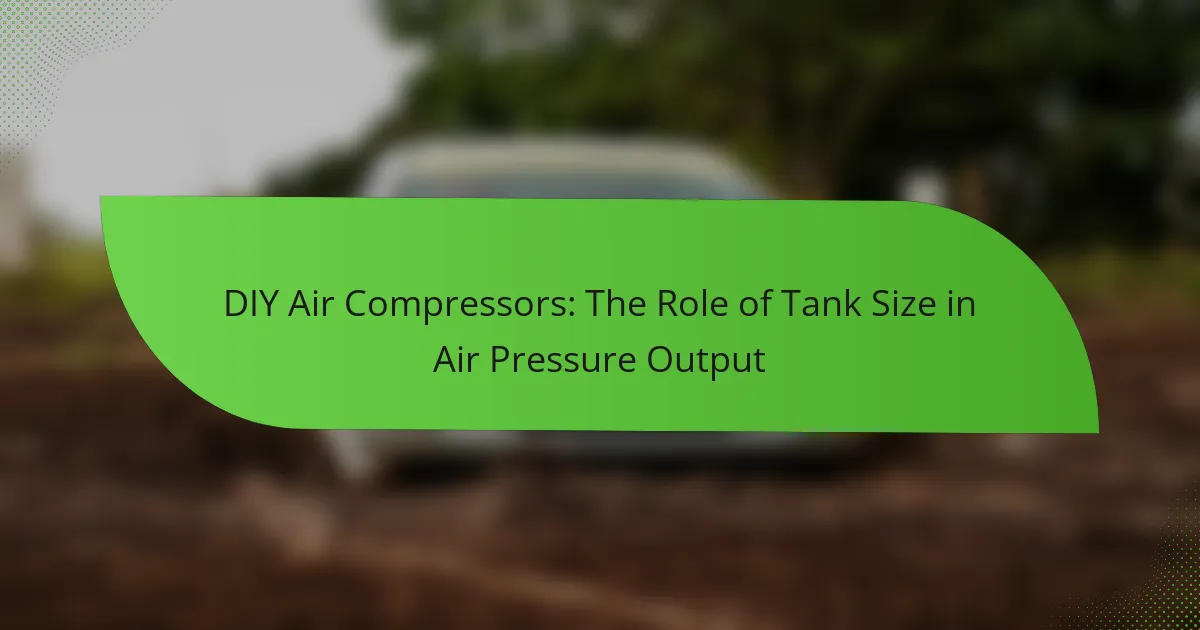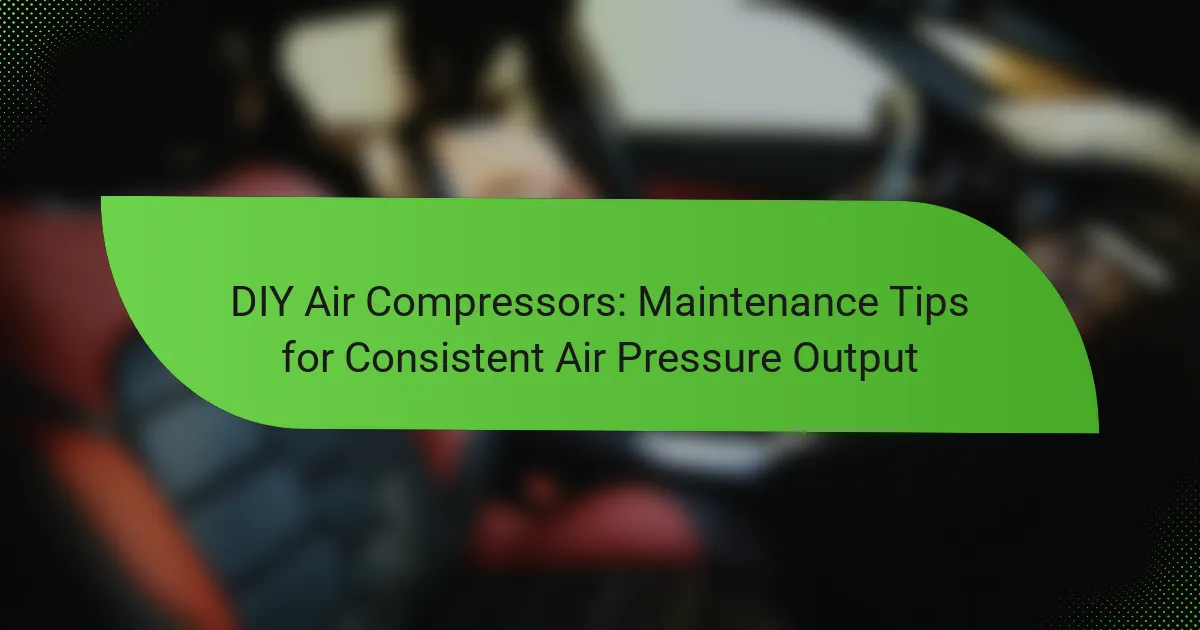DIY air compressors are homemade devices designed to compress air for various applications, utilizing repurposed components such as old motors and tanks. This article outlines best practices for maximizing air pressure output in these compressors, including proper sizing, high-efficiency pumps, regular maintenance, and the importance of air tank size. Key maintenance tasks include checking air filters, oil levels, and moisture buildup, as well as ensuring tight connections to prevent air leaks. Following these guidelines will enhance performance and longevity, making DIY air compressors a cost-effective solution for tasks like inflating tires and powering pneumatic tools.
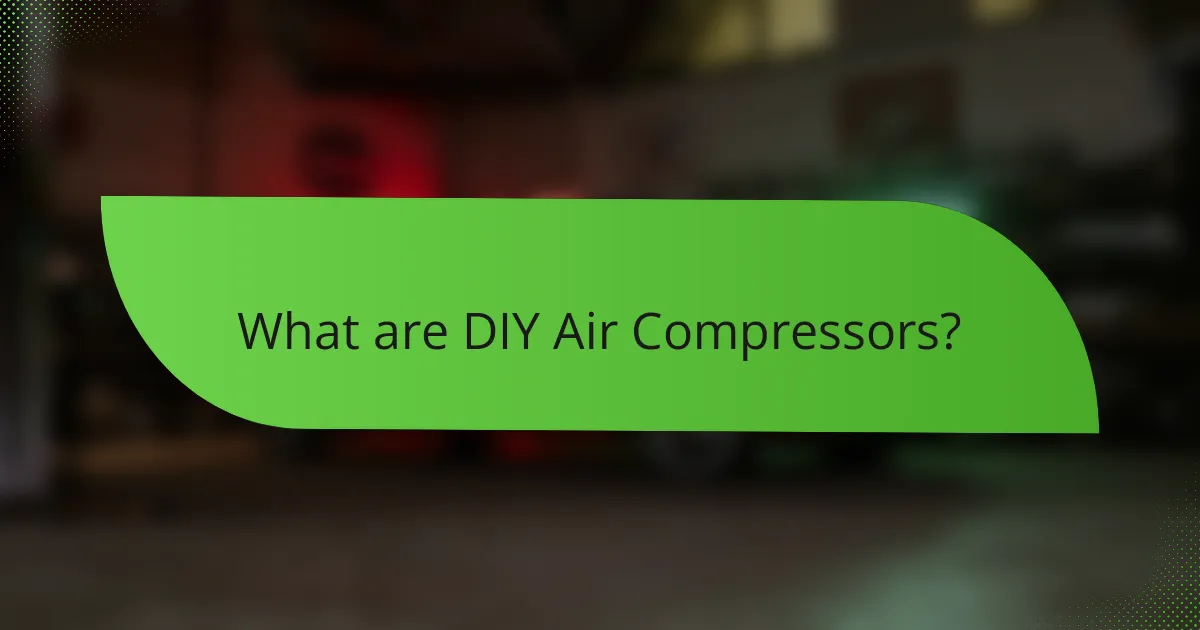
What are DIY Air Compressors?
DIY air compressors are homemade devices used to compress air for various applications. They often utilize repurposed components like old motors or tanks. These compressors can be built from scratch or modified from existing equipment. Common uses include inflating tires, powering pneumatic tools, and spraying paint. DIY air compressors provide a cost-effective solution for individuals needing compressed air. They can be tailored to specific needs and projects. Proper construction and safety measures are essential for effective operation.
How do DIY Air Compressors function?
DIY air compressors function by converting mechanical energy into compressed air. This process typically involves a motor that drives a piston or diaphragm. The motor generates power, causing the piston to move within a cylinder. As the piston moves down, it creates a vacuum that draws in air. When the piston moves back up, it compresses the air into a storage tank. The compressed air is then released through a valve when needed. This sequence allows for the storage of pressurized air for various applications. DIY air compressors can be built using accessible components like a compressor pump and a storage tank. The efficiency of the compressor depends on the motor’s power and the design of the components.
What components are essential for building a DIY Air Compressor?
Essential components for building a DIY air compressor include a motor, a compressor pump, an air tank, and a pressure switch. The motor provides the necessary power to operate the compressor pump. The compressor pump compresses air and pushes it into the air tank. The air tank stores the compressed air for later use. A pressure switch regulates the air pressure within the system. Additional components may include an air filter, pressure gauge, and safety valve for optimal operation. Each component plays a crucial role in ensuring the air compressor functions effectively.
How do each of these components contribute to air pressure output?
The components of a DIY air compressor significantly influence air pressure output. The motor provides the necessary power to compress air. A stronger motor generates higher pressure levels. The compressor pump compresses the air, increasing its density. This process directly correlates to the pressure output measured in PSI (pounds per square inch). The tank stores compressed air, allowing for consistent pressure delivery. A larger tank can maintain pressure longer during usage. The pressure switch regulates the air pressure, ensuring it does not exceed safe levels. This component maintains optimal pressure for various applications. Lastly, the air filter prevents contaminants, ensuring efficient operation and longevity of the system. Clean air intake supports better pressure performance by reducing blockages.
What are the advantages of using DIY Air Compressors?
DIY air compressors offer several advantages. They are cost-effective compared to commercial options. Building your own allows for customization to meet specific needs. DIY units can be tailored for size, power, and pressure output. This adaptability makes them suitable for various tasks. Furthermore, assembling a DIY air compressor can enhance technical skills. It provides a deeper understanding of how air compression works. Users can also easily repair or upgrade their units. Lastly, DIY compressors can be made from readily available materials, increasing accessibility.
How do DIY Air Compressors compare to commercial models?
DIY air compressors generally offer lower performance compared to commercial models. Commercial air compressors typically provide higher pressure and larger tank capacities. For instance, commercial models can deliver pressures up to 150 PSI, while DIY versions often max out around 90 PSI. Additionally, commercial units are designed for continuous use, ensuring durability and reliability. DIY compressors may lack this robustness, leading to shorter lifespans. Commercial models also come equipped with advanced features like automatic shut-off and better filtration systems. These features enhance efficiency and safety during operation. Overall, while DIY air compressors can be cost-effective for light tasks, they are not a substitute for the power and reliability of commercial models.
What cost savings can be achieved with DIY Air Compressors?
DIY air compressors can save users significant costs. Building a DIY air compressor typically requires lower initial investment compared to purchasing a commercial model. Users can source materials from local suppliers or repurpose existing equipment, further reducing expenses. Labor costs are minimized since individuals can complete the assembly themselves.
According to a study by HomeAdvisor, DIY projects can save homeowners an average of 30-50% on labor costs. Additionally, maintenance and repair costs can be lower for DIY compressors, as users can perform repairs without service fees. Overall, opting for a DIY air compressor can lead to savings of hundreds of dollars over time.
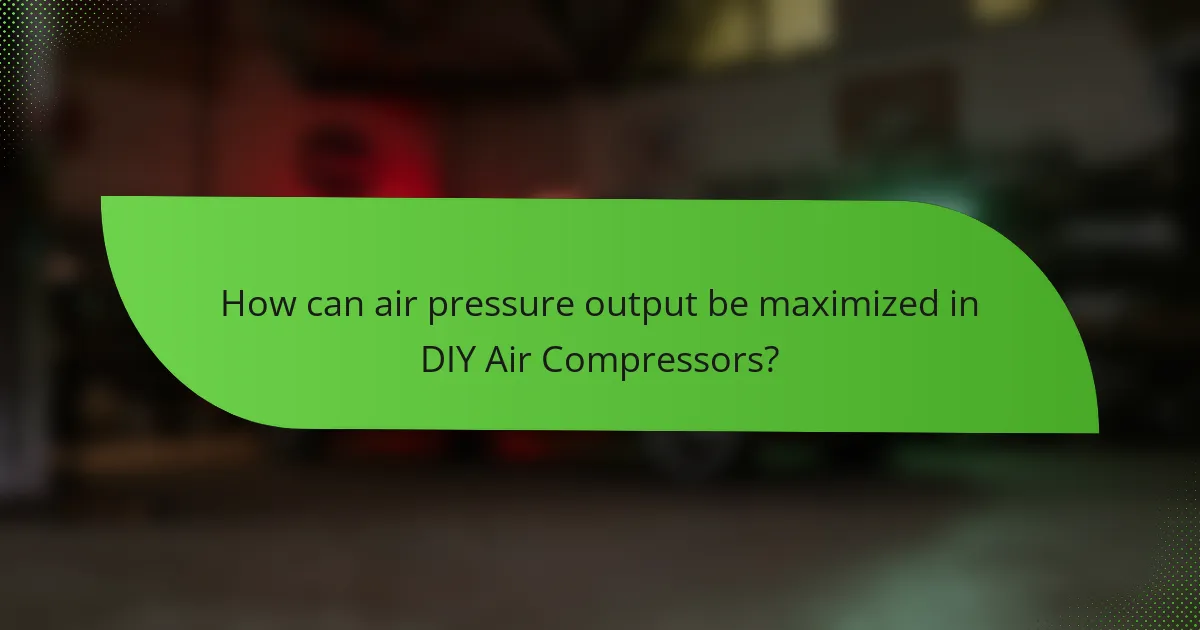
How can air pressure output be maximized in DIY Air Compressors?
To maximize air pressure output in DIY air compressors, ensure the compressor is properly sized for the intended application. Using a high-efficiency pump can significantly increase pressure levels. Regular maintenance of the compressor, including cleaning filters and checking for leaks, is crucial. Utilizing a larger air tank allows for better pressure retention. Installing a pressure regulator can help maintain consistent output pressure. Additionally, minimizing the length and diameter of air hoses reduces pressure loss during delivery. Finally, optimizing the motor’s power output can enhance overall compressor performance. These practices are supported by industry standards that emphasize efficiency and maintenance for optimal air pressure.
What techniques are effective for increasing air pressure?
Increasing air pressure can be achieved through several effective techniques. One method is reducing the volume of the air chamber. This increases pressure as the same amount of air occupies a smaller space. Another technique involves increasing the temperature of the air. Warmer air expands, leading to higher pressure readings.
Using a compressor with a higher horsepower rating also boosts air pressure output. Compressors with larger tanks can store more air, which can be released at higher pressures. Regular maintenance of the compressor ensures optimal performance. Cleaning filters and checking for leaks prevents pressure loss.
These techniques are supported by the ideal gas law, which states that pressure is directly proportional to temperature and inversely proportional to volume. This law validates the effectiveness of the methods mentioned.
How does tank size impact air pressure output?
Tank size directly impacts air pressure output by determining the volume of compressed air available. A larger tank can store more air, which allows for sustained pressure over a longer duration. When the tank is larger, it can maintain a more consistent pressure level during operation. Conversely, a smaller tank depletes faster, leading to fluctuations in air pressure.
For example, a 20-gallon tank can provide air at a stable pressure for longer than a 5-gallon tank. This is crucial for tools that require a continuous air supply. Air pressure output is also influenced by the compressor’s ability to refill the tank. A compressor with a higher CFM (cubic feet per minute) rating can refill a larger tank more efficiently, maintaining optimal pressure levels.
What role does the compressor motor play in air pressure efficiency?
The compressor motor is crucial for air pressure efficiency. It powers the compressor to draw in air and compress it. The motor’s performance directly influences the compressor’s ability to generate and maintain air pressure. A high-efficiency motor can reduce energy consumption while maximizing output. Conversely, a low-efficiency motor may lead to energy waste and inadequate pressure levels. Consistent motor operation ensures stable pressure delivery during use. The motor’s design and power rating also affect the compressor’s overall performance. Efficient motors typically have a higher duty cycle, allowing for extended operational periods without overheating.
What common mistakes should be avoided when building DIY Air Compressors?
Common mistakes to avoid when building DIY air compressors include using inadequate materials. Low-quality components can lead to leaks and failures. Incorrect sizing of the tank can reduce efficiency. A tank that is too small may not hold enough air. Failing to properly seal connections leads to air loss. Overlooking safety features can result in dangerous situations. Not using appropriate pressure gauges can cause mismanagement of air pressure. Lastly, neglecting to follow manufacturer specifications can compromise the entire system. These mistakes can hinder performance and safety.
How can improper assembly affect air pressure output?
Improper assembly can significantly reduce air pressure output in air compressors. Misaligned components can create leaks, leading to a loss of pressure. Loose fittings or connections may allow air to escape. Insufficient sealing can also contribute to reduced efficiency. Each of these issues directly impacts the compressor’s ability to maintain optimal pressure levels. According to industry standards, proper assembly ensures airtight connections, which are crucial for maximum performance. Research indicates that even small misalignments can decrease output by up to 20%. Therefore, careful assembly is essential for achieving desired air pressure levels.
What safety precautions are essential during the DIY process?
Essential safety precautions during the DIY process include wearing appropriate personal protective equipment (PPE) such as goggles, gloves, and masks. These items protect against potential hazards like flying debris and harmful fumes. Additionally, ensuring proper ventilation in the workspace minimizes inhalation of harmful vapors. Using tools according to manufacturer instructions prevents accidents and equipment damage. Keeping a first aid kit nearby allows for immediate response to injuries. Regularly inspecting tools and equipment for wear or damage enhances safety and performance. Following these precautions significantly reduces the risk of accidents and injuries during DIY projects.
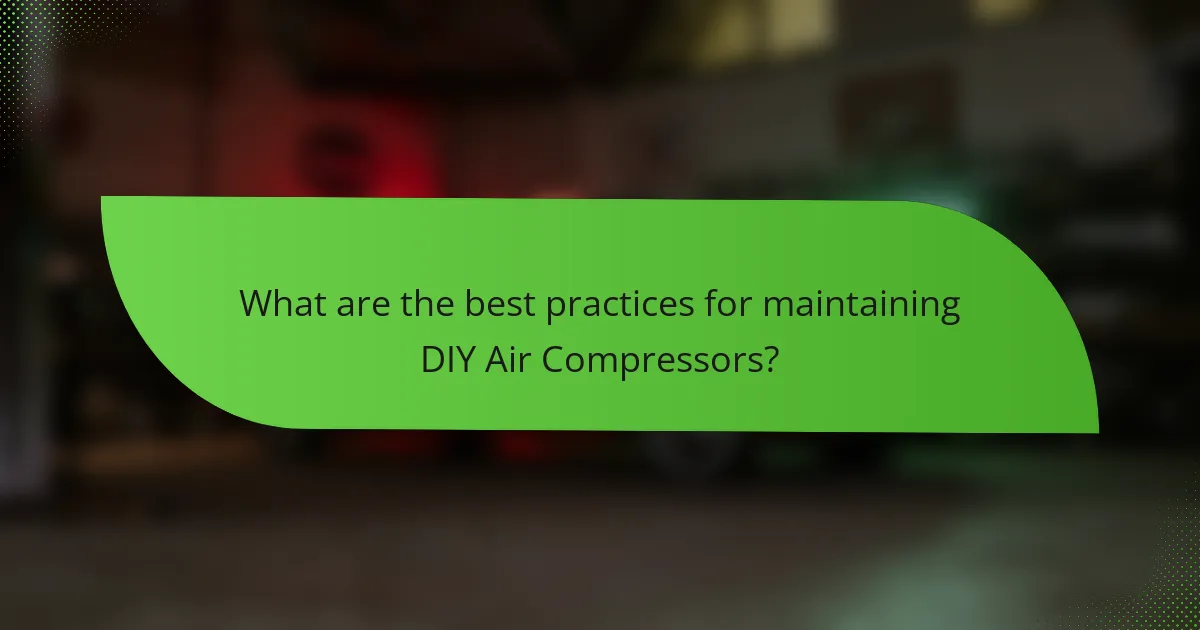
What are the best practices for maintaining DIY Air Compressors?
Regularly check the air filter of DIY air compressors. A clean air filter ensures optimal airflow. Replace or clean the filter as needed.
Inspect the oil level if the compressor is oil-lubricated. Adequate oil levels prevent overheating and wear. Change the oil according to the manufacturer’s recommendations.
Drain the moisture from the tank frequently. Moisture buildup can lead to rust and corrosion. This should be done after each use or daily.
Tighten all connections and fittings. Loose connections can cause air leaks. Regularly inspect them for wear and replace as necessary.
Keep the compressor in a dry and well-ventilated area. This prevents moisture accumulation and overheating. Ensure the area is free from debris and flammable materials.
Check the pressure gauge regularly. Accurate readings help maintain proper pressure levels. Replace faulty gauges to ensure efficiency.
Follow the manufacturer’s maintenance schedule. Adhering to guidelines ensures longevity and performance. Consult the user manual for specific maintenance tasks.
How often should maintenance be performed on DIY Air Compressors?
Maintenance on DIY air compressors should be performed every three to six months. This frequency ensures optimal performance and longevity of the equipment. Regular checks include inspecting the oil level, draining moisture from the tank, and cleaning or replacing air filters. Neglecting maintenance can lead to decreased efficiency and potential breakdowns. According to manufacturer guidelines, following this maintenance schedule helps prevent costly repairs and ensures safety during operation.
What specific maintenance tasks are crucial for optimal performance?
Regular maintenance tasks for DIY air compressors include checking and replacing the air filter, draining the moisture from the tank, and inspecting the hoses and fittings for leaks. These tasks ensure optimal performance and longevity of the compressor. The air filter should be cleaned or replaced every few months to prevent clogging. Draining the tank removes accumulated moisture, which can cause rust and damage. Inspecting hoses and fittings helps maintain air pressure and efficiency. Following these maintenance tasks can significantly enhance the compressor’s reliability and output.
How can users troubleshoot common issues with DIY Air Compressors?
Users can troubleshoot common issues with DIY air compressors by following these steps. First, check the power supply to ensure the compressor is plugged in and the circuit breaker is not tripped. If the compressor does not start, inspect the pressure switch for malfunction. A faulty pressure switch can prevent the compressor from operating.
Next, listen for unusual noises that may indicate mechanical problems. If the compressor is running but not building pressure, check for leaks in the hose or fittings. Leaks can significantly reduce pressure output.
Additionally, examine the air filter for clogs. A dirty filter restricts airflow and affects performance. Clean or replace the filter if necessary.
Finally, monitor the compressor’s duty cycle. Running the compressor for too long without breaks can lead to overheating. Allowing it to cool down can prevent damage.
These troubleshooting steps are effective in identifying and resolving common issues with DIY air compressors.
What tips can enhance the performance of DIY Air Compressors?
To enhance the performance of DIY air compressors, ensure proper maintenance and optimal setup. Regularly check and replace air filters to maintain airflow efficiency. Use a larger tank to store more compressed air, which increases pressure stability. Ensure all connections are airtight to prevent leaks that reduce performance. Incorporate a pressure regulator to maintain consistent pressure levels during operation. Use high-quality hoses and fittings to minimize pressure drop. Additionally, insulate the compressor to prevent heat loss, which can affect performance. Regularly monitor the compressor’s temperature to avoid overheating, which can lead to inefficiency.
How can proper ventilation affect air pressure output?
Proper ventilation can significantly enhance air pressure output in compressors. Adequate airflow allows the compressor to operate efficiently. It prevents overheating, which can lead to reduced performance. Proper ventilation also helps maintain a consistent temperature. A stable temperature ensures optimal air density. Increased air density contributes to higher pressure output. Studies indicate that compressors with sufficient ventilation can achieve up to 20% more efficiency. This efficiency translates into better air pressure performance during operation.
What accessories can improve the functionality of DIY Air Compressors?
Pressure regulators enhance the functionality of DIY air compressors. They maintain consistent air pressure for various tools. This prevents damage to equipment and improves performance. Air hoses are essential for connecting tools to the compressor. High-quality hoses reduce pressure loss and improve airflow. Quick-connect fittings allow for easy attachment and detachment of tools. They streamline workflow and save time during projects. Air filters protect the compressor from dust and debris. Clean air extends the lifespan of the compressor and tools. Lastly, moisture traps prevent water accumulation in the air lines. This is crucial for maintaining tool integrity and performance.
DIY air compressors are homemade devices designed to compress air for various applications, utilizing components like old motors and tanks. This article provides a comprehensive overview of how DIY air compressors function, essential components for construction, advantages over commercial models, and effective techniques for maximizing air pressure output. It also covers maintenance best practices, common mistakes to avoid, and troubleshooting tips to enhance performance and efficiency. Overall, the content aims to equip readers with the knowledge needed to build, maintain, and optimize DIY air compressors for their specific needs.

